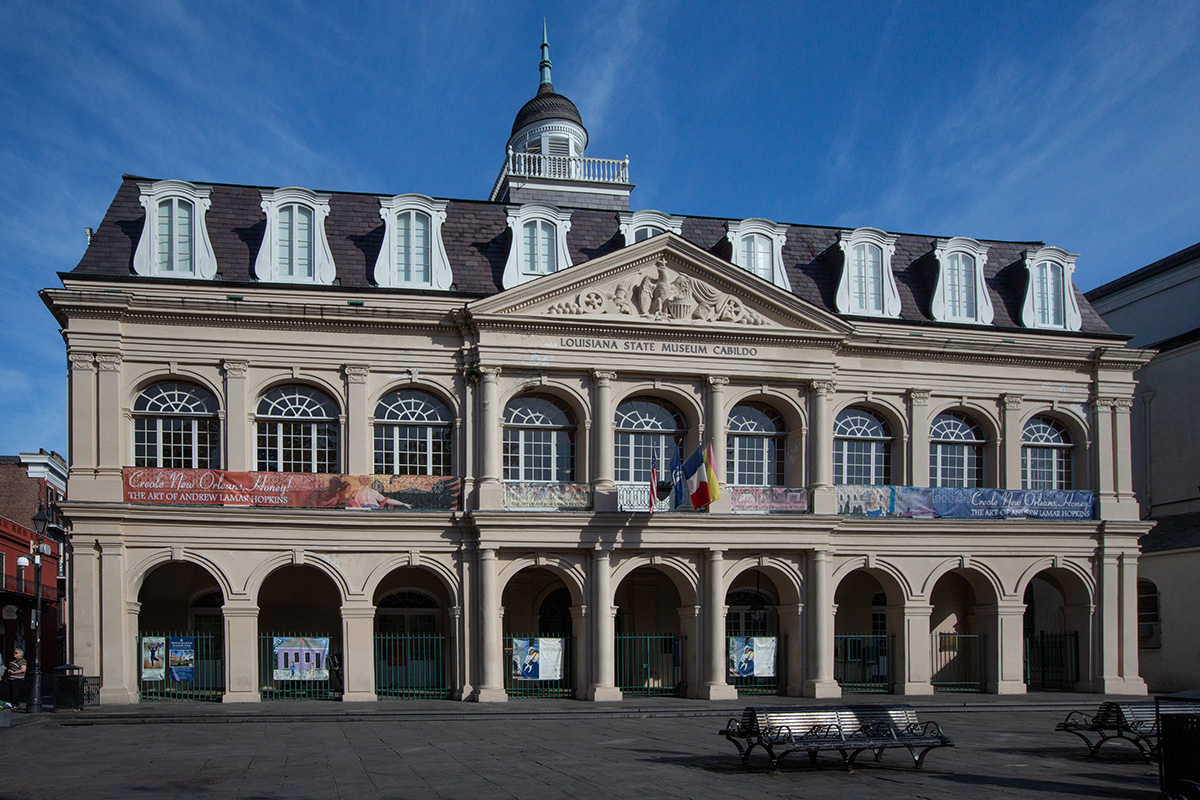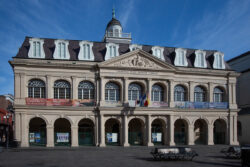Cabildo
The Cabildo, one of three eighteenth-century structures that anchor New Orleans's Jackson Square, stands as a visual monument to Spanish rule in Louisiana.

The Louisiana Endowment for the Humanities
The façade of the Cabildo, 2023. Melissa Carrier, photographer
The Cabildo, one of three eighteenth-century structures that anchor the French Quarter’s iconic public space (today’s Jackson Square), stands as a visual monument to Spanish rule in New Orleans (1769–1803), as well as one of the nation’s most significant historical landmarks. Constructed between 1794 and 1799 after the devastating fires of 1788 and 1794 felled earlier government structures on the site, in 1803 the Cabildo served as the setting for both the retrocession of the colony of Louisiana from Spain to France and the subsequent transfer of the colony to the United States—the Louisiana Purchase—an event which nearly doubled the land mass of the young country. In addition, for more than one hundred years, the Cabildo has functioned as the flagship component in the Louisiana State Museum system, which includes the Presbytere, the 1850 House, the Old United States Mint, and Madame John’s Legacy in the French Quarter, as well as other properties throughout the state.
Predecessors (1718–1794)
On the 1721 plan of New Orleans, French military engineers Louis-Pierre LeBlond de La Tour and Adrien de Pauger designated land along the lakeside (northern side) of Chartres Street opposite the public square as the settlement’s public center. The parish church was to be located in the middle, flanked symmetrically by property set aside for government on the upriver (eastern) side and for religious use on the other. By 1731, the following French colonial structures had been constructed on the site of today’s Cabildo: police station (corps de garde), criminal court (chambre criminel), with its keepers lodge (chambre du concièrge), and prison cells (cachots) in the rear courtyard. By 1751 a more substantial masonry building replaced the earlier wood and masonry corps de garde at the corner of Chartres and St. Peter Streets; and in 1769 Spanish governor Alejandro O’Reilly commissioned a new building for the newly established Spanish governing body, or Cabildo, at the corner of Chartres and today’s Pirates Alley. The fire of 1788 heavily damaged the corps de garde, the first Cabildo, jail, parish church, and the rectory. The thick brick walls of the 1751 corps de garde, however, survived the fire and received a new roof. As indicated during the 1968–69 renovation of the second or extant Cabildo, walls of the French colonial building were incorporated in both the first and second Spanish colonial municipal structures. At that time, the left side of the first floor was restored as an eighteenth-century guard station.
The Second Cabildo (1794–1908)
From construction after the fire of 1794 until its transfer by the city to the board of curators of the Louisiana State Museum in 1911, the new Cabildo served governmentally: as the administrative seat of the Spanish crown in Louisiana (1794–1803), the New Orleans City Hall (1803–1836), and the Municipal Hall for the heavily Creole-populated First Municipality during the period when New Orleans was divided into three districts (1836–1852). Soon after the fire, Spanish-born philanthropist Don Andres Almonester y Roxas promised to lend money for the construction of a new Cabildo, provided that its design match that made for the Presbytere in 1791 after the fire of 1788. For the twin-arcaded, flat-roofed two-story buildings, French-born architect Don Gilberto Guillemard used the formal neoclassical style, commonly used for eighteenth-century Spanish colonial government structures. Guillemarde’s Cabildo covered the site of the ruined, separate corps de garde and Cabildo, reusing the brick wall remnants. Especially noteworthy features of the new Cabildo are its delicate wrought ironwork executed by Marcelino Hernandez, an immigrant from the Canary Islands, and plaster corbels above the second floor interior gallery doors, sculpted by Cristobal Le Prevost.
Completed by 1799, years before the Presbytere was finished in 1813, the Cabildo housed the corps de garde on the first floor and on the second floor the Sala Capitular, or council chamber, where the Louisiana Purchase was consummated. Under the portico lining the front of the building, law enforcement and judicial officials oversaw court-ordered sales of enslaved people and other movable property. Not until 1821 was the Spanish coat of arms removed from the façade pediment and replaced with the extant American eagle with cannon balls by the Italian sculptor Pietro Cardelli. Several early-nineteenth-century depictions (an 1815 sketch by city surveyor Jacque Tanesse, an 1819 drawing by Benjamin Latrobe, and an 1845 lithograph by Jules Lion) show the Cabildo and Presbytere before the addition of the mansard-roofed third floors.
In the mid-nineteenth century, major modifications were made to the Cabildo. In 1847, influenced probably by preliminary schemes for the Pontalba Buildings and eager to compete with the Anglo-Americans and their new city hall (Gallier Hall), the Creole district’s city council voted to add a mansard roof, popular in French architecture, and cupola to its seat of government. The wardens of St. Louis Cathedral followed suit and added a similar roof and cupola to the Presbytere, thereby creating the dramatic vista still evident today. Circa 1850, the Cabildo received a coat of brown stucco scored to resemble stone. Elaborate wrought iron entry gates were installed, and the entry hall was paved with marble. Despite these improvements, when city government was consolidated in 1853, the council moved into Gallier Hall. After the city council’s removal, the police station remained on the first floor, and the Louisiana Supreme Court met in the more elaborate second floor spaces. For many years the extensive royal jail was located behind the Cabildo. In the late 1830s, it was demolished and the vacant sites sold, including that of the Arsenal, designed in 1839 by architect James H. Dakin. In 1859 a new three-story block of prison cells was built at the rear of the Cabildo. These remain and were restored in the 1968–69 renovation to an 1850 appearance.
The Cabildo as the Louisiana State Museum
In the late nineteenth century, city courts were scattered throughout the city. In 1895 the city council decided to build a new Supreme Court on the site of the Cabildo and a new civil district courts building on that of the Presbytere, requiring demolition of both structures. A resounding public outcry ensued, resulting not only in preservation of the Spanish colonial monuments but ultimately in their use for the burgeoning Louisiana State Museum (LSM). The genesis of the LSM lay in Louisiana’s display at the Louisiana Purchase Exposition (1904) in St. Louis, Missouri, which included a full-sized replica of the Cabildo and other artifacts. After completion in 1908 of the Civil District Court (400 Royal Street), the city transferred ownership of the Cabildo and Presbytere to the LSM. For many years, the Cabildo housed the historical collection and the Presbytere the natural history exhibits, with academic Robert Glenk serving as curator (1906–1934).
The Cabildo and the LSM have endured a number of disasters and vicissitudes during the twentieth century. The hurricane of 1915 damaged the Cabildo and Presbytere; and in the late 1960s, a major restoration involving historical research and archaeology followed Hurricane Betsy (1965) with Maxwell & LeBreton as architects and Koch and Wilson as associates. In 1988, fire destroyed the Cabildo’s mansard roof and cupola, as well as part of the LSM’s outstanding Louisiana furniture collection. The museum building reopened in 1994 after reconstruction of the damaged architectural features. In the late 1990s, a jurisdictional conflict erupted between the LSM and the Vieux Carré Commission, a city agency created in 1936 by a state constitutional amendment. The issue, over the necessity of a permit from the commission for the installation of a fence enclosing the Cabildo’s façade loggia, was decided by the Louisiana Supreme Court in favor of the museum. In addition, stewardship of the LSM frequently has been subject to the whim of politics. Over the years, efforts have been made to professionalize the museum operations, with accreditation of the LSM occurring in 1974, and to emphasize the building’s architectural and historical associations, resulting in the survival of the Cabildo as both an invaluable national landmark and as a vital museum component.
